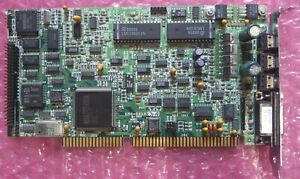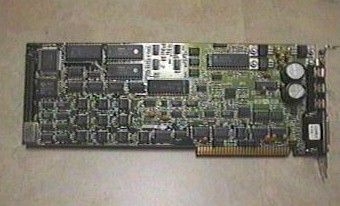Mediavision Pro AudioSpectrum / Plus
The Pro AudioSpectrum (or Pro Audio Spectrum as it's often incorrectly named) was introduced in May 1991, and was the first PC sound card to support stereo FM music - it had two OPL2 chips onboard, one for each channel, left and right.
|
Released | May 1991 |
| Bus | ISA 8-bit | |
| Chipset | MVD101 | |
| FM Synth | 2 x Yamaha YM3812 (OPL2) | |
| Standards | Ad Lib, ProAudio Spectrum | |
| Ports | Stereo Line-in, Stereo Line-out and Mic-In 3.5mm jacks DB15 MIDI/game port |
|
| Part # | 650-0002-00 (Pro AudioSpectrum) 650-0002-01 (Pro AudioSpectrum) 650-0014-XX (Pro AudoSpectrum Plus) |
|
| FCC ID | IXW-PAR (Pro AudioSpectrum) IXW-MVIPAS2 (Pro AudioSpectrum Plus) |
|
| Price | At launch: $295 (PAS) Nov 1993: $179 (PAS) |
|
| See Also | ProAudio Spectrum 16 |
Creative later did this on their Sound Blaster Pro, launched in November of the same year. The PAS is Ad Lib compatible, but in mono only. One unique feature is that it emulated the PC speaker - it did this via its onboard 8253 timer chip, listening on the bus for I/O writes. This differed from the Sound Blaster Pro and later cards that had a 2-pin header on the card to mix in PC speaker audio. The PAS PC speaker emulation can also apply a RealSound filter to make RealSound PWM-style audio sound less distorted. This is configurable via the mixer program.
The Pro Audio Spectrum Plus arrived in 1992, and was essentially a mid-point between the original Pro Audio Spectrum (PAS) and the Pro Audio Spectrum 16 (PAS16). It gained Sound Blaster compatibility with the addition of MV's Thunder Board chipset, as well as a true MPU-401 MIDI interface via the game port.
Comparing the PAS Plus to the original PAS, the key difference is that the original PAS had two OPL2 chips - the PAS Plus combined these into a single OPL3 chip. This results in incorrect music when playing games designed specifically for the two OPL2 chips. An example of this is Sierra Online's SCI1-based games. From SCI1.1 games, Sierra launched both 8-bit and 16-bit drivers for the PAS range.
Like the PAS16, the Plus is backwardly compatible with Ad Lib, Sound Blaster 1.5 and the original PAS. Where it's different is that it lacks the 16-bit digital audio sampling (recording) capabilities of the PAS16, so 22 kHz is where the Plus tops out for recording, though like the PAS16, it can playback at the full 16-bit audio frequency of 44.1 kHz.
One key benefit of the PAS was that it was well shielded from electrical interference - something the Creative cards were not - making its output very clean.
The MVD101 chipset cannot properly support a daughterboard header, suffering from occasional hanging notes.
The following games titles were directly supported by the PAS:
|
|
There are games from Sierra Online that support this card in stereo FM for music that do not support the Sound Blaster Pro.
On the backplate, from top, the 3.5mm jacks are: Stereo Line-in, Stereo Line-Out, and Microphone-In.
Board Revisions
I have no information on the various board revisions for the PAS or PAS Plus.
Competition
In the Media
Never before have such sonic riches been within such easy reach of PC users. The Pro AudioSpectrum sports a 22-voice MIDI-compatible stereo synthesizer, as well as a sampler for recording and playing back high-quality digitized audio. You can connect a microphone and stereo sound source and run all output to a stereo amplifier. A SCSI interface even lets you hook up a CD-ROM drive to use as a CD player, while an optional MIDI connector supports MIDI keyboards.
With the software-controlled mixer, you can adjust the volumes of each sound source independently. Most impressive of all is that you can mix all sound sources and record them simultaneously as a digitized audio file. The on-board stereo sampler's 8-bit PCM (pulse code modulation) sampling at 44.1 kHz doesn't match the 16-bit sampling of studio equipment, but the final results are darn good.
The Pro AudioSpectrum also comes as part of Media Vision's $995 internal MPC upgrade kit, which includes a Sony CD-ROM drive with all necessary cables and drivers, Multimedia Extensions for Windows (free to present owners of Pro AudioSpectrum until December 31, 1991), and two free CD-ROM applications: Compton's Encyclopedia and Jones in the Fast Lane. Media Vision is also introducing a smartly designed $1,295 external MPC upgrade kit called the CDPC, which consists of an external case housing a CD-ROM drive and 100 watts of audio power delivered to small built-in high-fidelity speakers; the case unit is connected to the PC via a SCSI card. The CDPC also provides a joystick, extra speaker ports, full MIDI capability, and an analog mixer. It comes with the same free software as the internal kit.
Media Vision's product line and the Pro AudioSpectrum board in particular will help the PC finally overcome its long-standing reputation as something that should be seen but not heard."
PC Magazine, January 14, 1992
Setting it Up
The Pro AudioSpectrum card requires you to run MVSOUND.SYS in your CONFIG.SYS file for the card to work. The card is configured using jumpers as follows:
| Jumper | Meaning | Description |
|---|---|---|
| J1 | IRQ setting | 1 (leftmost jumper) = IRQ7* 2 = IRQ6 3 = IRQ5 4 (rightmost jumper) = IRQ3 |
| J2 and J3 | DMA channel | 2 blocks of 3 jumpers each - both must be set the same. 1 (leftmost jumper) = DMA channel 3 2 (middle jumper) = DMA channel 2 3 (rightmost jumper) = DMA channel 1 |
* default factory setting
The card also has some headers for external connection, as follows:
| Jumper | Meaning |
|---|---|
| J6 | PC speaker connector (connect this from your motherboard's Speaker pins) |
| J7 | CD Audio connector (connect this from the connector at the rear of your CD-ROM drive) |
| J10 | SCSI connector |
As I understand it, the PAS Plus needs to be configured for Sound Blaster mode - it is not enabled by default.
Downloads
User Manual Get in touch if you can provide this missing item! |
PAS Driver/Utility Disks A copy of the original floppy disks shipped with the PAS by Mediavision. |
PAS+ Windows 3.x Drivers Windows 3.x drivers for the PAS Plus by Mediavision.
|
Sony CD-ROM Fix for Windows If you have issues when using a Sony CDU-31 or CDU-33A drive connected to the PAS card in Windows. |
PAS Software Development Kit Includes the Technical Reference document, code samples, and more. |
PAS Utilities A collection of Pro AudioSpectrum series utilities and drivers |
More Pictures

Media Vision Pro AudioSpectrum Plus (1992)
